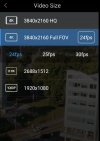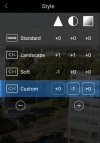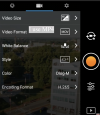Enjoy this 1:43 minute video of Sea of Grass, showing drone video and timelapse video of the Sea of Grass, the waterway and grassy plains of South Florida,USA. Production required over a 100 miles of driving, 6 hours of photography, and 12 hours of post-production using Adobe Premiere Pro, Adobe Photoshop, and LRTimelapse 5 software.
You are using an out of date browser. It may not display this or other websites correctly.
You should upgrade or use an alternative browser.
You should upgrade or use an alternative browser.
2 Pro Sea of Grass
- Thread starter Dale D
- Start date
Photo Beaty
Well-Known Member
- Joined
- Oct 16, 2016
- Messages
- 355
- Reactions
- 282
- Age
- 91
I would have to make a guess at about 30-40 feet. Could even be less. I was trying very hard to keep in VLOS. I was across the road from a national park, flying away from the park. I wanted to keep a very low profile. Just a little bit out and then right back. Finally found someone else on this forum around my age group.Very nicely done Dale. About how high above the grass was the drone?
Last edited:
Heindrich1988
Well-Known Member
DaveS
Well-Known Member
I always enjoy watching your videos Dale. This one looked a little over-exposed and like too much sharpness had been added. But, overall, very enjoyable.
Agree DaveI always enjoy watching your videos Dale. This one looked a little over-exposed and like too much sharpness had been added. But, overall, very enjoyable.
I am playing around w color grading and did move the exposure slider a bit too much to the right on this one
DaveS
Well-Known Member
Experimenting is the best way to learn. After 45 years in professional video production, I'm still running tutorials and learning all the time. Did you sharpen the video? if not, what is sharpening set at in your drone camera? Usually it's best to set it to zero or even -1. Then, if it looks a bit too soft in editing, you can add some sharpening back. Even on the best mirrorless cameras they tell you the same thing...Sony, Panasonic, Fuji and the rest, make great cameras but sharpening firmware is not the strong suit for any of them. Keep those video coming though Dale...always enjoyable!Agree Dave
I am playing around w color grading and did move the exposure slider a bit too much to the right on this one
Thanks Dave and others:Experimenting is the best way to learn. After 45 years in professional video production, I'm still running tutorials and learning all the time. Did you sharpen the video? if not, what is sharpening set at in your drone camera? Usually it's best to set it to zero or even -1. Then, if it looks a bit too soft in editing, you can add some sharpening back. Even on the best mirrorless cameras they tell you the same thing...Sony, Panasonic, Fuji and the rest, make great cameras but sharpening firmware is not the strong suit for any of them. Keep those video coming though Dale...always enjoyable!
I did a screen shot of my Mavic 2 Pro settings for video- please have a look and comment if agreed or not.



Nice video, good visuals. I found the bird song too overpowering (loud) at the beginning, and too repetitive. But I did enjoy the video.
Yes- you are right about the bird sound track. I stopped it completely about half the way through.Nice video, good visuals. I found the bird song too overpowering (loud) at the beginning, and too repetitive. But I did enjoy the video.
DaveS
Well-Known Member
Yes, that looks good Dale. I have the same settings. I have to admit, the video we shoot with our Mavic 2 Pro does seem noticeably sharper, even though I have sharpness set to zero, than the video from the camera on our old Inspire 1. I think the Hassleblad camera is just that much better. We always shoot .mov because we edit on Apple computers with Adobe Premiere, so we also use H.265 compression. We shoot everything at 30p and edit on a 30p timeline. We found that when we used 24p on a 30p timeline, viewers said there was "something wrong with the video" it appeared to stutter. We shoot for commercial purposed, not cinematic. Oh yes, one other thing, we usually shoot f4 or 4.5 and use ND to get the proper exposure. Supposedly this helps with sharpness too.Thanks Dave and others:
I did a screen shot of my Mavic 2 Pro settings for video- please have a look and comment if agreed or not.View attachment 116876View attachment 116877View attachment 116878
Thanks for this. I am constantly trying to refine my settings and standardize my work flow. I have been sort of "married" to 24 frame per second since my first love before drones was time lapse photography. I have been doing timelapse using Gunther Wegner's software since November, 2015 when I started using it for star scapes in Namibia. I shoot timelapse with the DSLR (Nikon D750) and I set the frame rate at 24 fps for all timelapse. I am sure you will note that more than half of my videos are timelapse clips.Yes, that looks good Dale. I have the same settings. I have to admit, the video we shoot with our Mavic 2 Pro does seem noticeably sharper, even though I have sharpness set to zero, than the video from the camera on our old Inspire 1. I think the Hassleblad camera is just that much better. We always shoot .mov because we edit on Apple computers with Adobe Premiere, so we also use H.265 compression. We shoot everything at 30p and edit on a 30p timeline. We found that when we used 24p on a 30p timeline, viewers said there was "something wrong with the video" it appeared to stutter. We shoot for commercial purposed, not cinematic. Oh yes, one other thing, we usually shoot f4 or 4.5 and use ND to get the proper exposure. Supposedly this helps with sharpness too.
So when I went to the drone (first the Mavic Air 1 red then the Mavic 2 Pro) , to keep everything video at 24 fps, I set the video to 24 fps too rather than 4K/30. I also set my Osmo Action and Osmo pocket to 4K/24fps. In LRTimelapse5 software I render at 16:9.
So when I import to Premiere, I have been trying to deal with the Black Bar curse , and set the frame size to avoid black bars. I think I have settled on SEQUENCE settings of custom, timebase 23.976 fps, Frame Size 3840x2160. Any comments, corrections, pointers, agreements or disagreements are most welcomed.
Finally, I must ask.... why do say it is necessary to shoot .MOV if using Apple? I heard this also from one of the tutorials from Jeff Greene. He didn't explain why. I have always shot drone footage using .MP4 and always edit on iMac or Mac Book Pro. You have seen my videos so you know this works ok, right? What am I missing?
Hi Dale,
MOV is a container file for Apple’s QuickTime codec. It is a proprietary standard created by Apple.
MP4 (MPEG-4) is an international standard, also a container file, and supports multiple codecs such as H.264 & H.265.
QuickTime is less compressed than an H.264 video clip and retains more quality at the expense of larger file sizes.
MOV is pretty much the standard used on Macs in the broadcast and professional industry.
H.264 is the codec standard used .mp4 files. However it cannot cope at resolutions above 4K.
H.265 was developed for that reason with support for 8K resolution and file sizes approximately half that of an H.264 file.
As QuickTime is native to Macs, I would be using that. So MOV would be a better option.
At the end of the day it is the codecs that define the image quality.
MOV is a container file for Apple’s QuickTime codec. It is a proprietary standard created by Apple.
MP4 (MPEG-4) is an international standard, also a container file, and supports multiple codecs such as H.264 & H.265.
QuickTime is less compressed than an H.264 video clip and retains more quality at the expense of larger file sizes.
MOV is pretty much the standard used on Macs in the broadcast and professional industry.
H.264 is the codec standard used .mp4 files. However it cannot cope at resolutions above 4K.
H.265 was developed for that reason with support for 8K resolution and file sizes approximately half that of an H.264 file.
As QuickTime is native to Macs, I would be using that. So MOV would be a better option.
At the end of the day it is the codecs that define the image quality.
Thanks for this great information. I am going to run the next project in .MOV, H.265, 4KHi Dale,
MOV is a container file for Apple’s QuickTime codec. It is a proprietary standard created by Apple.
MP4 (MPEG-4) is an international standard, also a container file, and supports multiple codecs such as H.264 & H.265.
QuickTime is less compressed than an H.264 video clip and retains more quality at the expense of larger file sizes.
MOV is pretty much the standard used on Macs in the broadcast and professional industry.
H.264 is the codec standard used .mp4 files. However it cannot cope at resolutions above 4K.
H.265 was developed for that reason with support for 8K resolution and file sizes approximately half that of an H.264 file.
As QuickTime is native to Macs, I would be using that. So MOV would be a better option.
At the end of the day it is the codecs that define the image quality.
TerryToast
Well-Known Member
If you’re clearly putting a lot effort into your productions Dale.Production required over a 100 miles of driving, 6 hours of photography, and 12 hours of post-production
One change that would make a big improvement in your footage, would be to time your filming so it occurs in Golden Hour. It’s a serious commitment to wake up before dawn so that you are on site for the dawn, but it’s so worth it.
Grapecrusher
Well-Known Member
Really enjoyed your video! I haven’t tried the time lapse yet and found the mix in your video of time lapse, stills and drone really interesting. Might try it when I get the opportunity. Keep flying, stay safe and look forward to more of your videos. ??
Scuddzy
Member
but,.....Gators!If you’re clearly putting a lot effort into your productions Dale.
One change that would make a big improvement in your footage, would be to time your filming so it occurs in Golden Hour. It’s a serious commitment to wake up before dawn so that you are on site for the dawn, but it’s so worth it.
Terry:If you’re clearly putting a lot effort into your productions Dale.
One change that would make a big improvement in your footage, would be to time your filming so it occurs in Golden Hour. It’s a serious commitment to wake up before dawn so that you are on site for the dawn, but it’s so worth it.
Totally agree with you, There is no question about it- both early and golden hours are ideal. If you watch my videos (Dale Davis,M.D.) you will see frequent sequences taken at dawn and dusk.
Similar threads
- Replies
- 4
- Views
- 795
- Replies
- 6
- Views
- 984
- Replies
- 6
- Views
- 951
- Replies
- 20
- Views
- 1K
Mini 4 Pro
Our Poland Trip
- Replies
- 3
- Views
- 1K
DJI Drone Deals
New Threads
-
Should Authorities reconsider line of sight with 360 drones ?
- Started by Pacefast
- Replies: 0
-
-
4 Pro Night Christmas Boats Parade
- Started by MikeReidPhotography
- Replies: 1
-
-
Mini 5 Pro Mist-erious Forest | West Coast rainforest with Mini 5 Pro & 3 Pro
- Started by DMD Cine Attic
- Replies: 4











